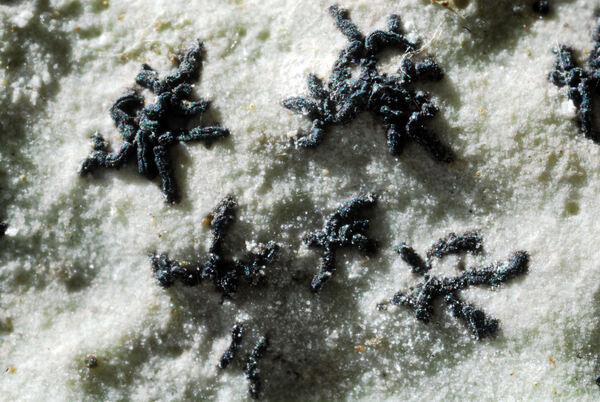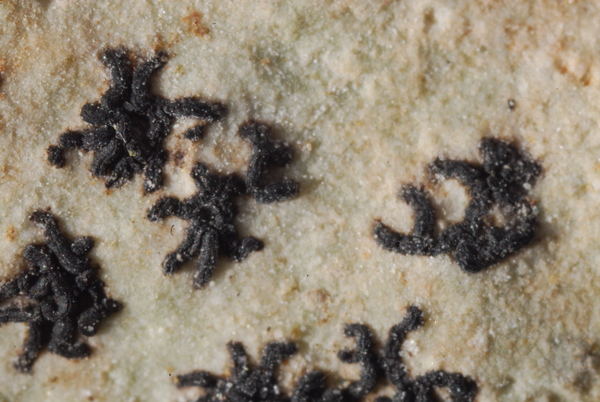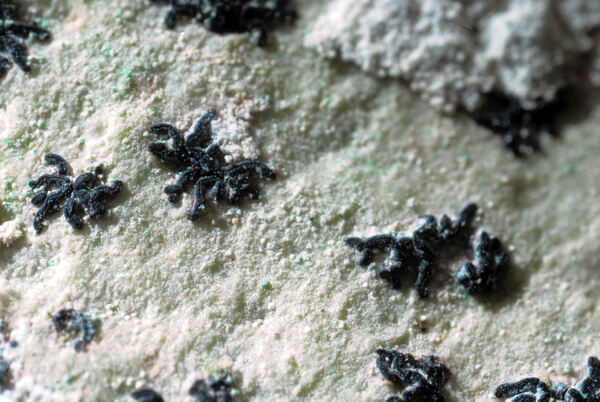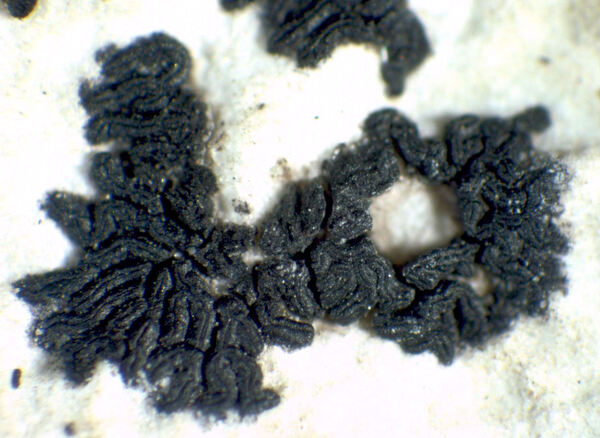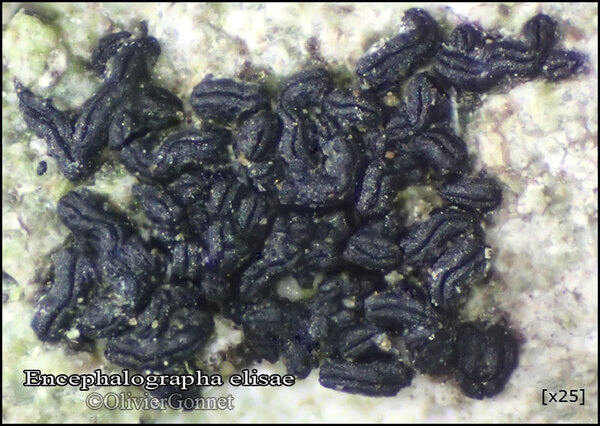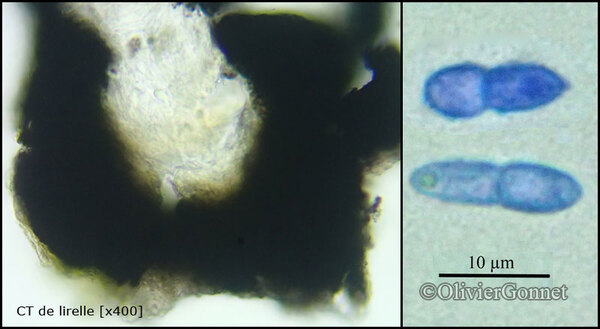Encephalographa elisae A. Massal.
Geneac. Lich.: 13, 1854.
Synonyms: Encephalographa cerebrina f. caesia Anzi; Encephalographa cerebrina var. elisae (A. Massal.) Anzi; Encephalographa rubiformis A. Massal.; Melaspilea rubiformis (A. Massal.) Redinger
Distribution: N - VG (Tretiach & Modenesi 1999, Tretiach & Rinino 2006), Frl (Tretiach & Modenesi 1999, Lazzarin 2000b), Ven (Tretiach & Modenesi 1999, Lazzarin 2000b, Watson 2014), Lomb, Piem. C - Tosc (Tretiach & Modenesi 1999), Laz (Nimis & Tretiach 2004), Sar (Tretiach & Modenesi 1999). S - Camp (Nimis & Tretiach 2004), Cal (Puntillo 1996, Tretiach & Modenesi 1999), Si (Nimis & al. 1994, Tretiach & Modenesi 1999, Grillo & al. 2007b).
Description: Thallus crustose, endosubstratic, poorly evident, yellowish white, often delimited by a black prothallus. Apothecia lirelliform, black, epruinose, 0.3-1 x 0.1-0.2 mm, simple or weakly dichotomously branched, laterally anastomosing, straight to curved, prominent, aggregated into 2-3 mm wide, stellate to irregular clusters of 10-20 apothecia, with a slit-like disc. Proper exciple dark brown to black, extending below the hymenium, brittle, the external layer of cells c. 2-3 µm wide, with strongly occluded lumina; epithecium brown; hymenium colourless, I- or I+ yellowish; paraphysoids highly branched and densely anastomosing, c. 2 µm thick; hypothecium dark. Asci 8-spored, clavate, bitunicate, with an evident ocular chamber, K/I- (but cytoplasm usually yellowish brown). Ascospores 1-septate, slightly constricted at septum, one cell slightly shorter and wider than the other, at first hyaline then pale brown, 12-16 x 4-6 µm, with a very thin perispore, the wall ornamented. Pycnidia frequent, half to totally immersed, carbonaceous in upper part, colourless in lower part, producing either macro- or microconidia. Macroconidia simple, ellipsoid, 7-11 x 3-5 µm; microconidia narrowly ellipsoid to bacilliform, 4-8 x 1-2.5 µm. Photobiont trentepohlioid. Spot tests: K-, C-, KC-, P-, UV-. Chemistry: without lichen substances.Note: a mild-temperate lichen found on compact calcareous rocks in shaded, microclimatically stable situations, often under overhangs; the species seems to be most frequent in Tyrrhenian Italy. For further details see Tretiach & Modenesi (1999).
Growth form: Crustose
Substrata: rocks
Photobiont: Trentepohlia
Reproductive strategy: mainly sexual
Most common in areas with a humid-warm climate (e.g. most of Tyrrenian Italy)
In underhangs rarely wetted by rain
Commonnes-rarity: (info)
Alpine belt: absent
Subalpine belt: absent
Oromediterranean belt: absent
Montane belt: absent
Submediterranean belt: very rare
Padanian area: absent
Humid submediterranean belt: rare
Humid mediterranean belt: very rare
Dry mediterranean belt: absent
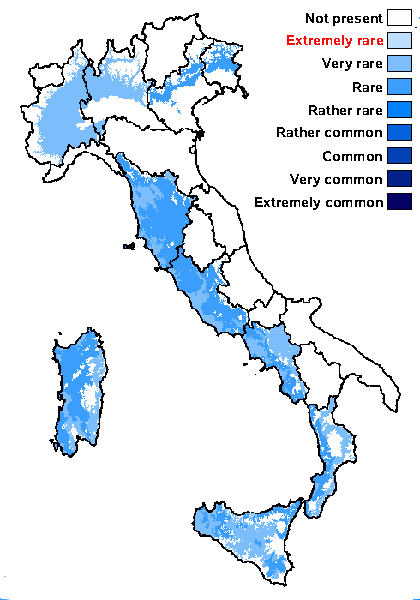
Predictive model
Herbarium samples
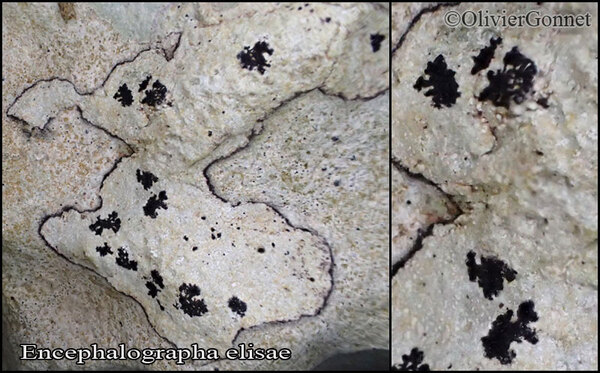
Courtesy Danièle et Olivier Gonnet - Source: https://www.afl-lichenologie.fr/Photos_AFL/Photos_AFL_E/Encephalograpga_elisae.htm
France, session AFL dans le Lot - Moulin du Saut, Gramat
25/5/2015
Growth form: Crustose
Substrata: rocks
Photobiont: Trentepohlia
Reproductive strategy: mainly sexual
Most common in areas with a humid-warm climate (e.g. most of Tyrrenian Italy)
In underhangs rarely wetted by rain
Commonnes-rarity: (info)
Alpine belt: absent
Subalpine belt: absent
Oromediterranean belt: absent
Montane belt: absent
Submediterranean belt: very rare
Padanian area: absent
Humid submediterranean belt: rare
Humid mediterranean belt: very rare
Dry mediterranean belt: absent

Predictive model
| Herbarium samples |

 Index Fungorum
Index Fungorum
 GBIF
GBIF
